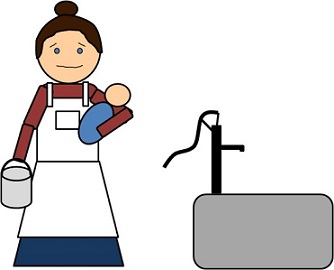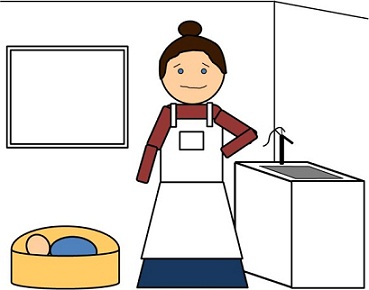THE TAKE AWAY
Suburbia and The Family Unit
Domestic Engineering
By Kersley Fitzgerald

Two years ago, we spent the tax refund on a new vacuum. It's very retro—the kind with the big metal bell for a base and a fabric bag hanging on the handle. But it'll suck up sand like nobody's business, and it'll last forever.
Not that it's in any danger of getting all used up anytime soon. Housework is not one of my spiritual gifts. I buck, unconsciously, at my mom's admonition to dust. I have a friend who always keeps her house neat in case it's needed by the church. My goal is more to build up my friends' self esteem by letting them know their house is just fine.
But this summer, our family's going through a revolution. Dev, my husband, just retired from the Air Force. I got a job. JT's way too young to be let loose on the world. So Dev is staying home for the summer to hang out with him.
...And to do the laundry and cook meals and vacuum and fill my new refrigerator. Such a revolution in suburban life has not been seen since the time of Harriet Beecher Stowe's older sister Catharine.
Way back in the long ago...
Throughout most of human history, there had been two types of residential areas: urban and rural. Urban areas were crowded, dangerous in social ways, and dirty; but you lived close to your job. Rural areas were spread out, dangerous in natural ways, dirty, and far from the job; but you had a horse.
Beginning in about 1820, a combination of a strong middle class, filth from the industrial revolution, and advances in transportation completely transformed the way we think about our expected living conditions. A new creature developed. One with the health, and loneliness, of rural living, and the social standing of the city: the suburb.
Suburbs back then started much as they continue to grow now. Some were all-inclusive (I'm talking amenities here, not people) enclaves for the rich to escape their city apartments and enjoy fresh air and sunshine. Some were more haphazard and appealed to the middle class as a way to invest their hard-earned money and escape inner-city tenements. As dreadfully fascinating as all that is, what is even more interesting is the effect this had on the family dynamic.
Back in the day, middle-class families lived in row houses in big cities. They were close to shopping and their neighbors. Many homes had servants (this can be seen in such incongruous places as base housing on Hickam AFB, HI, where several units include small bedrooms and bathrooms for the household maid). The man worked in the city but lived close enough that he managed most of the domestic affairs as well.
With industry came factories. Cities were dense; sanitation wasn't great. It wasn't the safest place for ladies, either. Street cars and "omnibuses" (horse-drawn carts that could carry a lot of people) as well as ferries made the "borderlands" (the farms just outside the city) much more accessible than they had been in the past. The rich took advantage by buying country homes to occasionally escape to. The poor, who couldn't afford the transportation costs, stayed in the tenements. The middle class couldn't afford two houses, but they could afford to travel back and forth, so they moved to the suburbs.
So, you have thousands of families who are used to a small house surrounded by other small houses with a small yard and servants. And you move them to a good sized house on a half-acre with no servants (the poor can't afford to live there!). Added to that, the men must commute up to an hour each way every day. What a shock for the women! I honestly don't know what they did with their time before, but suddenly they're responsible for cooking, cleaning, gardening, raising the children — things we take for granted now but must have been a hard transition at the time. Lucky for them, they had Catharine Beecher.
Catharine Beecher may have been the first home economist but she was much more. She was a talented architect, and studied mechanical engineering and sanitation engineering to better her home plans. Her books included advice on architecture, landscape architecture, interior design, cooking, cleaning, and child-raising. She also taught on things like "how to take care of an invalid, how to plant a garden, and how to build a healthful home which eased a woman's labors." Her father had been a minister and her sister was abolitionist Harriet Beecher Stowe.

She's sounding a bit like Martha Stewart. But whereas Martha teaches people how to make lampshades by hand that they can pick up at Target, Catharine was educating an entire culture as they went through a monumental cultural shift.
Catharine's ambition in all things domestic had two major sources. One was, strangely enough, feminism:
She launched an assertive call for women's authority in the domestic sphere, but she had in mind a conservative version of women's lives, one that specified women's competence at home [which, remember, heretofore had been uncommon in the middle class] but surrendered it in public life. Hers was a "domestic feminism" in contrast to the "social feminism" of temperance advocates...and the "material feminism" of women who advocated pay for housework.But, gentle readers, the main influence on Catharine Beecher's life and work was her religion. Despite the fact that her father was a preacher, she never had a personal "conversion experience" and apparently was not saved. To fill that void, she turned to work — domestic work — and projected that standard on all women. I guess she took 1 Timothy 5 and Proverbs 31 seriously.
(Of course, there's no way of knowing definitely if a woman 150 years ago was a Christian or not. I don't base my assumption on the fact that she reportedly never had a conversion experience. The author (who I highly suspect is not a Christian due to the tone she takes) also says, "She [Beecher] felt that by staying clear of religious theory, a woman could gain salvation by practical dedication to the needs of others in a 'home church' of her own creation." You can certainly come to a saving grace of accepting that Christ died for your sins and rose again without a single, defining experience, but saying that you're saved by keeping a good house is works-based and has nothing to do with faith.)
Beecher urged women to take charge of the suburban house and family, which she called "the home church of Jesus Christ." She instructed them to stay home and master efficient house design and gardening, as well as the spiritual nurturing of large families...Her vision of domesticity was explicitly gendered: women were to create a peaceful domestic world, removed from the stresses of work in the city, and although women would find themselves excluded from the political and economic arenas of public life, they would receive a reward in heaven for their self-sacrifice...Her first book, in 1831, argued for the moral superiority of women, based upon women's dedication to self-sacrifice...[She] advised marrying early, giving up worldly activities, having ten children, and going without servants.Beecher herself? Well, she grew up "debating theology with highly educated men of the ministry." After a young fiancÚ drowned, she never married, never had children. Her writing, designing, and speaking schedule wouldn't have permitted a family life, anyway. But her mark is everywhere from the air conditioning vents in my office to the rampant undercurrent in American Christian Culture that women should be stay-at-home moms, domestic goddesses, and, preferably, home-schoolers. I believe that strong families are vital to a civilized society. So I am absolutely chagrined to know that the guilt I feel when I don't grow tomatoes, homeschool my kid, or vacuum, and struggle in my desire to work in engineering, the field in which I'm trained, or architecture, the field in which I'd like to be trained, (not to mention leave my husband at home and go to work) is the result of a non-Christian woman, an architect and engineer, 180 years ago, who never took care of a home or family.

Next: "Homework and the Suburban Family"
All quotes: Hayden, Dolores; Building Suburbia; Vintage Press; New York, NY; 2003.
comments powered by Disqus
Published 5-16-11

